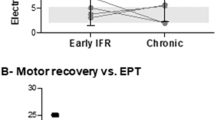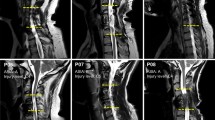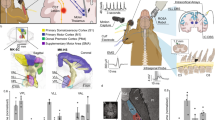Abstract
Cortical magnetic stimulation was performed in a consecutive series of 10 patients presenting within 15 days of traumatic spinal cord injury. In those patients with complete paraplegia or quadriplegia, motor evoked potentials at presentation were absent below the level of the lesion. Six months after the injury, potentials had returned in the biceps brachii and abductor pollicis brevis muscles in some quadriplegic cases, but remained absent from the tibialis anterior in all of this group. None of those with a complete lesion made a significant functional recovery. Of the three patients with incomplete quadriplegia, two showed a significant recovery after 6 months. Motor evoked potentials were recordable below the level of the lesion at presentation in these cases, although the latencies were prolonged. In the remaining patient who failed to improve, potentials were unrecordable throughout the study. This small pilot study suggests that cortical magnetic stimulation may be useful in refining the prognosis in patients with an incomplete spinal cord injury.
Similar content being viewed by others
Log in or create a free account to read this content
Gain free access to this article, as well as selected content from this journal and more on nature.com
or
References
Merton P A, Morton H B (1980) Stimulation of the cerebral cortex in the intact human subject. Nature 285: 227–228.
Barker A T, Jalinous R, Freeston I L (1985) Non-invasive magnetic stimulation of human motor cortex. Lancet i: 1106–1107.
Barker A T, Freeston I L, Jalinous R, Jarratt J (1986) Clinical evaluation of conduction time measurements in central motor pathways using magnetic stimulation of human brain. Lancet i: 1325–1326.
Hess C W, Med D, Mills K R et al (1987) Magnetic brain stimulation: Central motor conduction studies in multiple sclerosis. Ann Neurol 22: 744–752.
Ingram D A, Thompson A J, Swash M (1988) Central motor conduction in multiple sclerosis: Evaluation of abnormalities revealed by transcutaneous magnetic stimulation of the brain. J Neurol Neurosurg Psychiatry 51: 487–494.
Eisen A, Shytbel W, Murphy K, Hoirch M (1990) Cortical magnetic stimulation in amyotrophic lateral sclerosis. Muscle Nerve 13: 146–151.
Schady W, Dick J P R (1991) Motor studies in hereditary spastic paraparesis. J Neurol Neurosurg Psychiatry 54: 775–779.
Claus D, Harding A E, Hess C W et al (1988) Central motor conduction in degenerative ataxic disorders: A magnetic stimulation study. J Neurol Neurosurg Psychiatry 51: 790–795.
Jaskolski D J, Jarratt J A, Jakubowski J (1989) Clinical evaluation of magnetic stimulation in cervical spondylosis. Br J Neurosurg 3: 541–548.
Noordhout A M, Remacle J M, Pepin J L et al (1991) Magnetic stimulation of the motor cortex in cervical spondylosis. Neurology 41: 75–80.
Dominikus M, Grisold W, Jelinek V (1990) Transcranial electrical motor evoked potentials as a prognostic indicator for motor recovery in stroke patients. J Neurol Neurosurg Psychiatry 53: 745–748.
Heald A, Bates D, Cartlidge N E F et al (1992) Comparison of electromagnetic stimulation of the brain and CT scans in predicting functional outcome after stroke. J Neurol Neurosurg Psychiatry 55: 418.
Bracken M B, Shepard M J, Collins W F et al (1990) A randomized, controlled trial of methylprednisolone or naloxone in the treatment of acute spinal cord injury. N Engl J Med 322: 1405–1411.
Thompson P D, Dick J P R, Asselman P et al (1987) Examination of motor function in lesions of the spinal cord by stimulation of the motor cortex. Ann Neurol 21: 389–396.
Giantusos J, Eberstein A, Ma D et al (1987) A non-invasive technique to assess completeness of spinal cord lesions in humans. Exp Neurol 98: 34–40.
Brouwer B, Bugaresti J, Ashby P (1992) Changes in corticospinal facilitation of lower limb spinal motor neurons after spinal cord lesions. J Neurol Neurosurg Psychiatry 55: 20–24.
Lissens M A, McKay W B, Dimitrijevic M R, van der Linden C (1992) Transcranial motor cortex stimulation in patients with established spinal cord injury. In: Lissens MA, editor. Clinical Applications of Magnetic Transcranial Stimulation. Uitgeverij Peeters, Leuven: 42–55.
Tegenthoff M (1992) Clinical applications of transcranial magnetic stimulation in acute spinal cord injury. In: Lissens MA, editor. Clinical Applications of Magnetic Transcranial Stimulation. Uitgeverij Peeters, Leuven: 33–41.
Young W (1992) Medical treatments of acute spinal cord injury. J Neurol Neurosurg Psychiatry 55: 635–639.
Fehlings M G, Tator C H, Linden R D, Piper I R (1987) Motor evoked potentials recorded from normal and spinal cord-injured rats. Neurosurgery 20: 125–130.
Simpson R K, Baskin D S (1987) Corticomotor evoked potentials in acute and chronic blunt spinal injury in the rat: correlation with neurological outcome and histological damage. Neurosurgery 20: 131–137.
Levy W J, McCaffrey M, Hagichi S (1987) Motor evoked potentials as a predictor of recovery in chronic spinal cord injury. Neurosurgery 20: 138–142.
Perot P L, Vera C L (1982) Scalp recorded somatosensory evoked potentials to stimulation of nerves in the lower extremities and evaluation of patients with spinal cord trauma. Ann N Y Acad Sci 388: 359–268.
York D H, Watts C, Raffensberger M et al (1983) Utilization of somatosensory evoked potentials in spinal cord injury. Prognostic limitations. Spine 8: 832–839.
McGarry J, Friedgood D L, Woolsey R et al (1984) Somatosensory evoked potentials in spinal cord injuries. Surg Neurol 22: 341–343.
Chabot R, York D H, Watts C, Waugh W A (1985) Somatosensory evoked potentials evaluated in normal subjects and spinal cord-injured patients. J Neurosurg 63: 544–551.
Author information
Authors and Affiliations
Rights and permissions
About this article
Cite this article
Clarke, C., Modarres-Sadeghi, H., Twomey, J. et al. Prognostic value of cortical magnetic stimulation in spinal cord injury. Spinal Cord 32, 554–560 (1994). https://doi.org/10.1038/sc.1994.87
Issue date:
DOI: https://doi.org/10.1038/sc.1994.87



